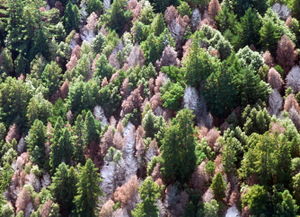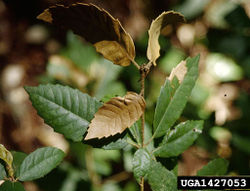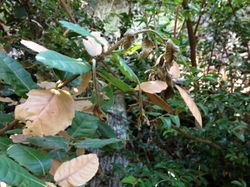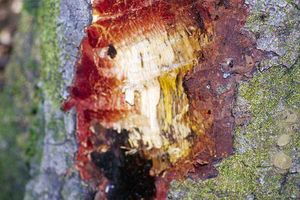Difference between revisions of "Sudden Oak Death (SOD)"
(→Phytophthora ramorum Hosts) |
(→Prevalence in Central California) |
||
| Line 54: | Line 54: | ||
== Prevalence in Central California == | == Prevalence in Central California == | ||
| + | |||
== Impacts == | == Impacts == | ||
=== Ecology === | === Ecology === | ||
Revision as of 03:04, 30 March 2017

This page discusses sudden oak death (SOD), an oak tree disease caused by the plant pathogen (Phytophthora ramorum).
Contents
Description
Sudden oak death (SOD) is a non-native forest disease that is believe to have originated from Asia and spread via international nursery trade. [1] The name of the disease is rooted in its initial discovery in 1995 when researchers in Marin County, California observed widespread rapid oak mortality.[2][3] Researchers later determined that SOD results from infection by Phytophthora ramorum, a type of water mold responsible for causing Ramorum Blight. [4]
P. ramorum affects many plant species. It can infect and cause mortality in coast live oak (Quercus agrifolia), California black oak (Quercus kelloggii), Shreve oak (Quercus parvula var. shrevei), canyon live oak (Quercus chrysolepis), and tanoak (Lithocarpus densiforus). Oak species vary in their susceptibility to P. ramorum infection. Tanoak and coast live oak have poor resistance to infection and experience high mortality rates.[5] Over 1 million trees have died due to SOD in Northern and Central California.[6]
P. ramorum can also cause twig and foliar diseases in species such as California Bay laurel (Umbellularia californica), Douglas-fir (Pseudotsuga menziesii), and coast redwood (Sequoia sempervirens). These species are often hosts of pathogen, primarily responsible for the pathogen's dispersal, but themselves do not die from the disease.
Symptoms
Foliar Blight


Foliar Blight and branch die-back are some of the early indicators of infection. One of the earliest indicators are a "Shepherd's Crook", or wilting of apical shoots. Other foliage-related symptoms include brown blotches on leaves, rapid browning leaves throughout the crown, tip droop and die-back, and branch die-back caused by branch cankers.[7][8] These symptoms, particularly the browning of the crown, occur 2 to 4 weeks after infection. However, trees typically do not die immediately after these symptoms appear. The latency period between foliar blight and death is around two years.[9]
Cankers and "bleeding"
Cankers are brown, water-filled abrasions that form on the bark of infected trees. Frequently, these legions can penetrate into the xylem. Cankers can damage the tree bark, leading to fracturing of bark and tree girdling. These symptoms can accelerate declines in tree health and expedite tree death.[10]

Cankerous regions release viscous sap. This black to amber hued fluid seeps out in a process typically referred to as "bleeding". [11]
P. ramorum Hosts in California
While all hosts species can be infected by SOD, not all species die from infection. Several species act as carriers that can potentially transfer the pathogen to sensitive species. Several hosts of P. ramorum have been identified worldwide[12]. The known hosts in California[13] are:
Oak species
- Coast live oak (Q. agrifolia)
- California black oak (Q. kelloggii)
- Shreve's oak (Q. parvula var. shrevei)
- Canyon live oak (Q. chrysolepsis)
- Tanoak (Lithocarpus densiflora)
Non-oak species
- Madrone (Arbutus menziesii)
- Evvergreen huckleberry (Vaccinium ovatum)
- Manzanita (Arctostaphylos spp.)
- Ornamental rhododendron (Rhododendron spp.)
- Bay laurel (U. californica)
- Big leaf maple (Acer macrophyllum)
- Toyon (Heteromeles arbutifolia)
- Salmon berry (Rubus spectabilis)
- California buckeye (Aesculus californica)
- Coffeeberry (Rhamnus californica)
- Cascara (Rhamnus purshiana)
- California hazelnut (Corylus cornuta)
- Honeysuckle (Lonicera hispidula)
- Viburnum (Viburnum spp.)
- Poison oak (Toxicodendron diversilobum)
- Western starflower (Trientalis latifolia)
- Coast redwood (Sequoia sempervirens)
- Douglas fir (Pseudotsuga menziesii)
Prevalence in Central California
Impacts
Ecology
Commerce
Humans
Management
Distribution and efficacy of remediation
Laws
Current Research
References
- ↑ US National Park Service
- ↑ US National Park Service
- ↑ (USDA) Department of Agriculture (US). 2003. Sudden Oak Death (SOD). UPlant Materials Technical Note. Montana: USDA. Available from: Technical Note Plant Materials MT-44
- ↑ California Oak Mortality Task Force
- ↑ UCR
- ↑ UCR
- ↑ UC BERKELEY FOREST PATHOLOGY AND MYCOLOGY LAB
- ↑ Sentinel Plant Network
- ↑ California Oak Mortality Task Force
- ↑ Garbelotto M. and Hayden KJ. 2012. Sudden Oak Death: Interactions of the Exotic Oomycete Phytophthora ramorum with Naïve North American Hosts. Eukaryotic Cell: 11(11):1313.
- ↑ Garbelotto M. and Hayden KJ. 2012. Sudden Oak Death: Interactions of the Exotic Oomycete Phytophthora ramorum with Naïve North American Hosts. Eukaryotic Cell: 11(11):1313.
- ↑ California Oak Mortality Task Force
- ↑ Rizzo DM. 2003. Sudden Oak Death: host plants in forest ecosystems in California and Oregon. In: Proceedings of sudden oak death online symposium. American Phytopathological Society, http://www. apsnet. org/online/SOD
Links
Disclaimer
This page may contain student work completed as part of assigned coursework. It may not be accurate. It does not necessary reflect the opinion or policy of [CSUMB], its staff, or students.